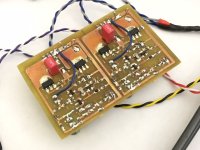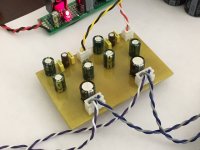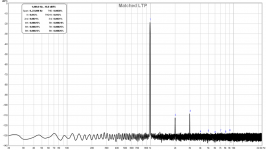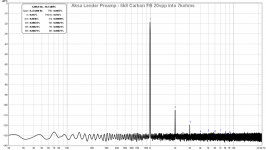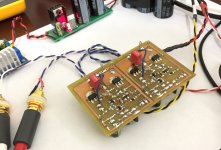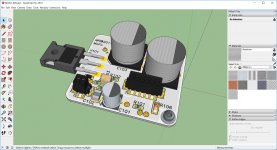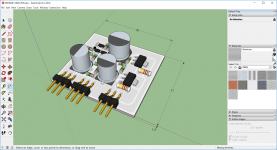Pawel,
That's an interesting topology and a very nice to interface with a tube.
No doubt I think Broskie is one of the smartest sausages at the picnic...... I have many useful ideas from him. I would love to meet him.
Hugh
That's an interesting topology and a very nice to interface with a tube.
No doubt I think Broskie is one of the smartest sausages at the picnic...... I have many useful ideas from him. I would love to meet him.
Hugh
Initial listening tests of the V1.6 SMT version in stereo is very promising. Sound is clear, neutral, noise free and massive amounts of dynamics and headroom. This preamp can drive almost any amp to clipping that's for sure. My listening test was performed with the Silicon Harmony SE Class A amp and both speakers (0.40x Karlsonator with 3FE25) and OB-1 headphones. I just did a quick build to make sure it works and did not have time to match the SMT BC857 LTP stage yet. The DZT5401 seems pretty happy with a 16.9mA bias (same on both channels) set by the 47R on the BSP129 CCS. I can confirm that the CCS works as current remained stable as amp Vcc was ramping up slowly to 40v. Ramp provided by IRF610 cap multiplier after the DC step up but before the CRCRC.
Photo of test setup with DC step up, cap multiplier, and CRCRC visible:

Closeup of SMT side. The 1uF Wima bypass can go on other side in the future if I had remembered to put a dogleg bend in the Panasonic 220uF 50v output caps:
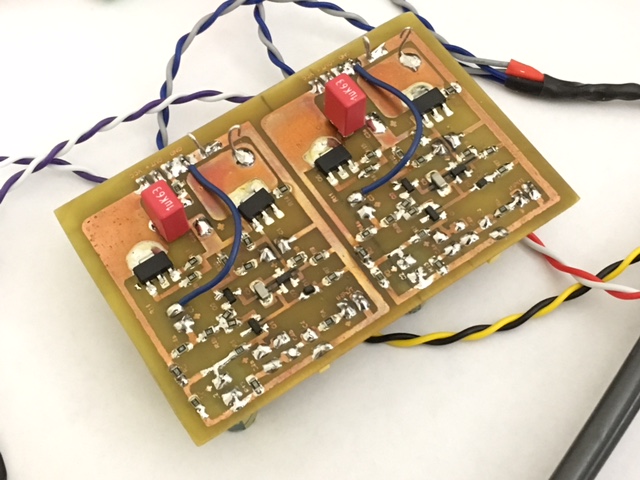
Through hole side with 100uF 50v caps, 10uF 35v Silmic II input cap with 100nF 100v polyester bypass, RFI input filter is 220pF 100v polyester, all JST connector construction:
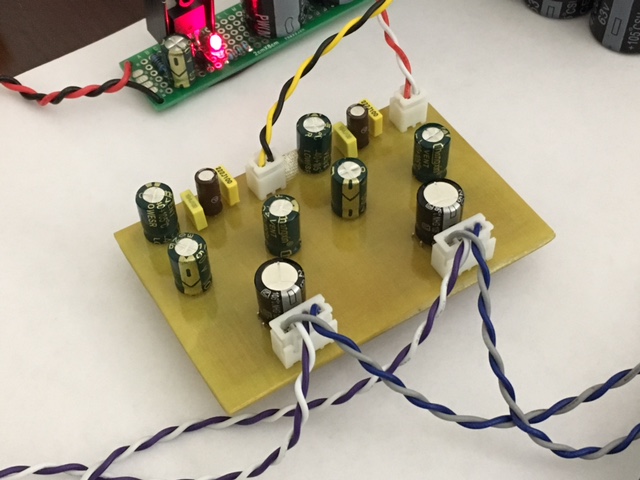
Photo of test setup with DC step up, cap multiplier, and CRCRC visible:
Closeup of SMT side. The 1uF Wima bypass can go on other side in the future if I had remembered to put a dogleg bend in the Panasonic 220uF 50v output caps:
Through hole side with 100uF 50v caps, 10uF 35v Silmic II input cap with 100nF 100v polyester bypass, RFI input filter is 220pF 100v polyester, all JST connector construction:
Attachments
Last edited:
Measurement of SMT prototype
Here is the measured FFT for 20vpp into 7kohm load, running 47R degeneration resistors (R5/R6), and 8.2k feedback resistor (R10) from schematic on v1.6. I am getting about 0.0025%THD and mostly second harmonic, and a little less third and not much else. After installing matched input LTP transistors, that did not change the measured THD or profile very much. So I would almost say that matching them is not needed. It is important to use a carbon resistor on the feedback (R10) though.
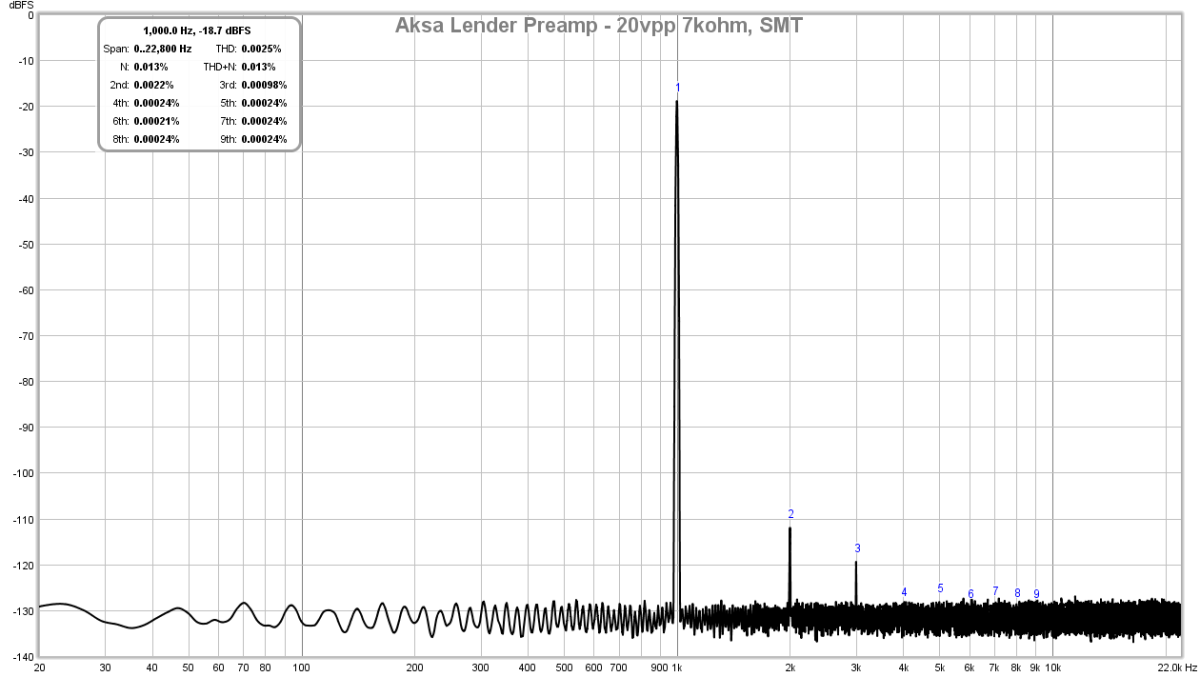
Here is the measured FFT for 20vpp into 7kohm load, running 47R degeneration resistors (R5/R6), and 8.2k feedback resistor (R10) from schematic on v1.6. I am getting about 0.0025%THD and mostly second harmonic, and a little less third and not much else. After installing matched input LTP transistors, that did not change the measured THD or profile very much. So I would almost say that matching them is not needed. It is important to use a carbon resistor on the feedback (R10) though.
Attachments
How so ?......It is important to use a carbon resistor on the feedback (R10) though.
Dan.
How so ?.
Dan.
You get this with a metal film feedback resistor:
Attachments
You can't imagine the painful process I just went through to find the above. It goes to show that on critical audio path, carbon sounds better than metal resistors. I have proof that carbon sounds better now (for select critical resistors).
Who knows, Dan.
I've noticed this before but X has just confirmed it with measurement. Bloody hell, what is this? Seems like the fb resistor removes some of the H3. Very odd........ but confirms that some people love some of the Japanese expensive resistors because they remove some of the H3. Hmmm........
HD
I've noticed this before but X has just confirmed it with measurement. Bloody hell, what is this? Seems like the fb resistor removes some of the H3. Very odd........ but confirms that some people love some of the Japanese expensive resistors because they remove some of the H3. Hmmm........
HD
Last edited:
So I finally get to sit back and put on some headphones and connect my Silicon Harmony to this preamp and enjoy some music. Man, it sounds good. The depth of imaging seems to be very good with this combo. The SH is zero global feedback, and this preamp seems to do a great job on providing a very realistic soundstage and realism of dynamics on percussion.
I am listening to a high res FLAC of Patricia Barber's Manha de Carnaval (acoustic, just her voice and hand claps). Very nice... 😀
I am listening to a high res FLAC of Patricia Barber's Manha de Carnaval (acoustic, just her voice and hand claps). Very nice... 😀
Was that measurement off the full SMT version?
EDIT- whoops, you said it in the post title. My apologies.
EDIT- whoops, you said it in the post title. My apologies.
Last edited:
I just reduced the feedback resistor to 6k8 (carbon) since I do not need so much gain, and this has a nice feature that they relative reduction of third harmonic vs second harmonic is down -15dB which is a very nice ratio to have. Although total THD went up to 0.0047%, this does not bother me and is a worthwhile tradeoff for -15dB differential between H2 and H3.
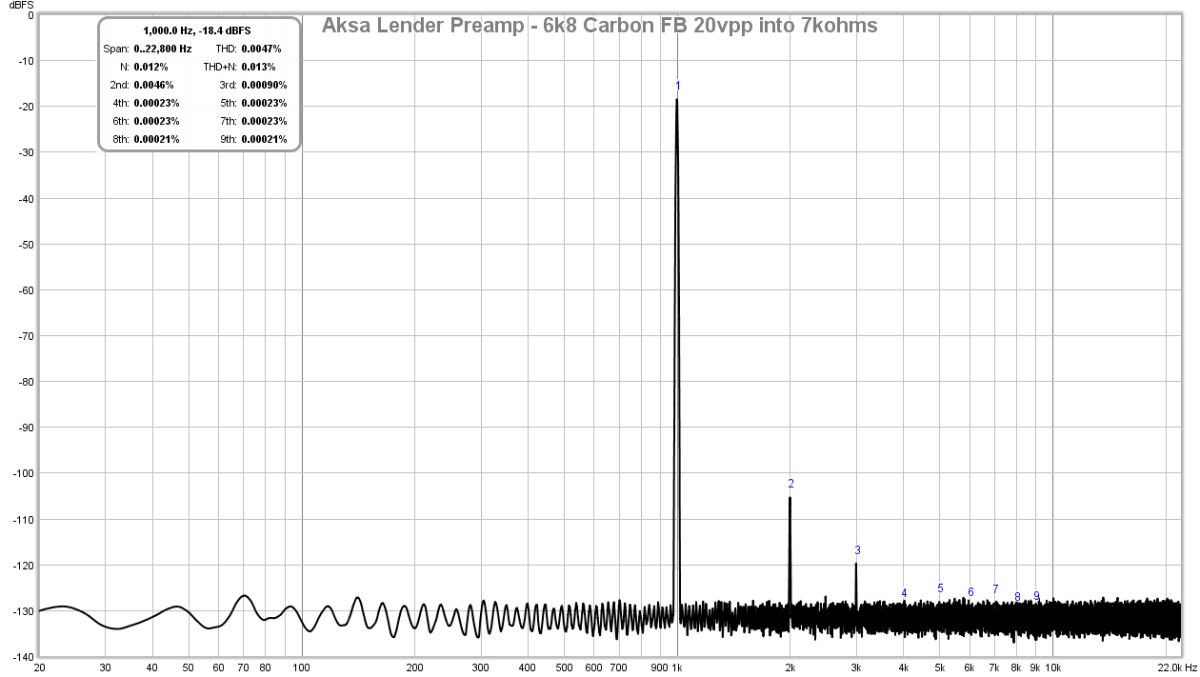
Here is what the preamp looks like with the one carbon resistor sticking up where it counts:
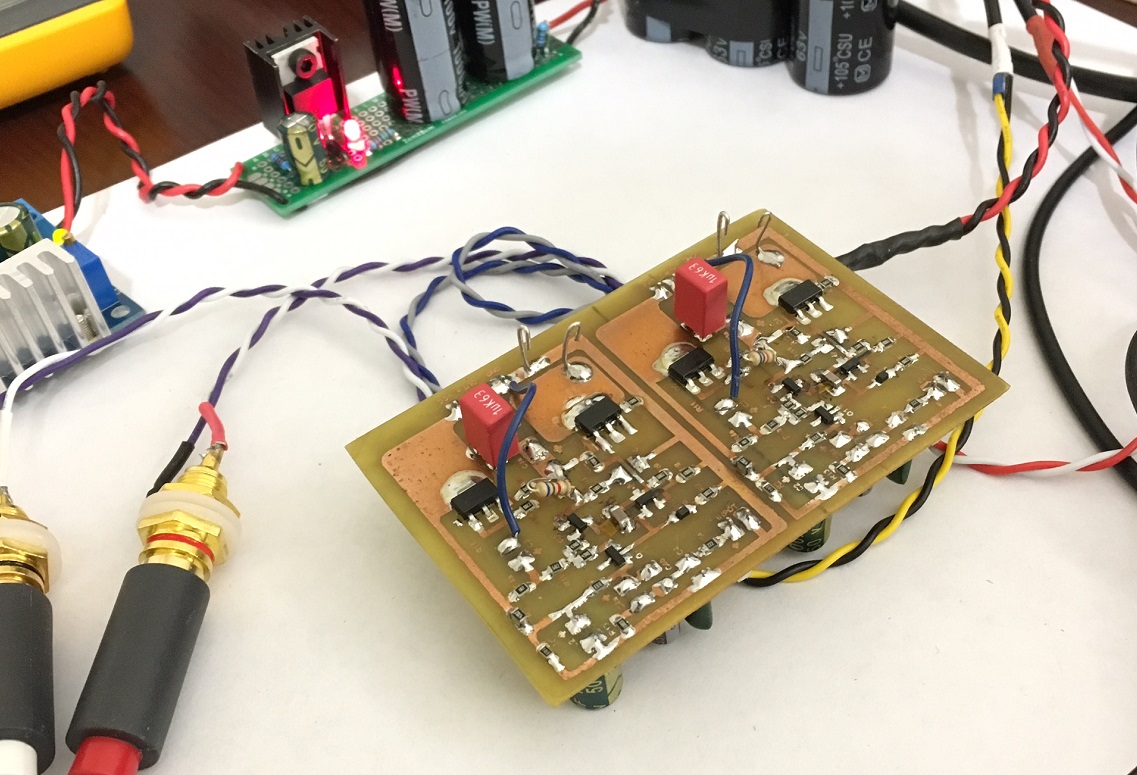
Anyone who has listened to an amp with a harmonic profile like this before knows what I am talking about. Sublime directness and naturalness of presentation. Superb. I am done tweaking this preamp, and will declare victory because I love the sound. Can't stop listening.
Here is what the preamp looks like with the one carbon resistor sticking up where it counts:
Anyone who has listened to an amp with a harmonic profile like this before knows what I am talking about. Sublime directness and naturalness of presentation. Superb. I am done tweaking this preamp, and will declare victory because I love the sound. Can't stop listening.

Attachments
Last edited:
It is what I thought after listening to your fourteen amplifiers, liking more the class A amp F5 (with 2SK2013/2SJ313) of Juma. But only 25 watts.
The VHEX+, more clean but without the harmonics: "some anecoic sound"
The VHEX+, more clean but without the harmonics: "some anecoic sound"
Very good result, X.
If you can change the gain about 2x - 4x with same result, I think it would be a useful pre-amp. We can put a volume control before this pre-amp.
And then build a good voltage regulator for it.
If you can change the gain about 2x - 4x with same result, I think it would be a useful pre-amp. We can put a volume control before this pre-amp.
And then build a good voltage regulator for it.
@xrk971
Sketch of your IRF610 cap multiplier and CRCRC setup?
Why not first metal core prototype? (MoFo already metal core routed).
JP
Similar to this sketch:

I am following the basic Juma mosfet cap Mx but using a 100uF50v cap instead of 220uF on input and two 1000uF 100v caps on output. These just happen to be the only caps I have rated for 50v. I am using 100nF and 2.2R snubber. For CRCRC I am using 4700uF 63v caps and 0.33R resistors.
Very good result, X.
If you can change the gain about 2x - 4x with same result, I think it would be a useful pre-amp. We can put a volume control before this pre-amp.
And then build a good voltage regulator for it.
Thanks, Bimo. I can boost the gain about 2x this but the relative H2/H3 will be closer together. Gain is currently about 17dB and I think this should be good for a lot of applications. Gain of 23dB is useful too and I will see what we can best achieve. It may require adjusting the degeneration resistors on the LTP.
Hi JPS64,
That's slick looking. You don't need to use those fancy round cylinders resistors - except the one for R10 needs to be carbon. Very slick compact package though. Header pin configuration is interesting because it means this can go onto a main amp board and not take too much space.
Can you please show a top view layout so I can check positioning?
Nice work!
Thanks,
X
Thank you @xrk971
First attempt: OSCON only 50VDC!
JP
I never thougth of using solid polymer caps for voltage reference filtering, since they have quite a bit leakage current, which translates into higher 1/f noise.
A cap multiplier is somehow related, is OS-CON really a good choice?
- Home
- Source & Line
- Analog Line Level
- AKSA's Lender Preamp with 40Vpp Output

